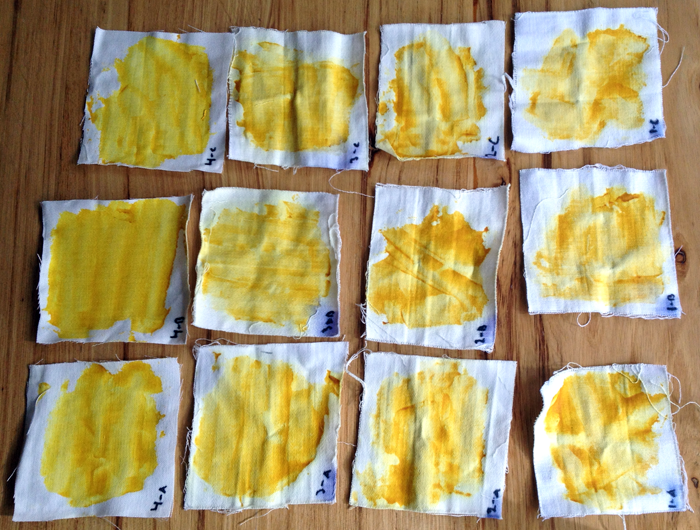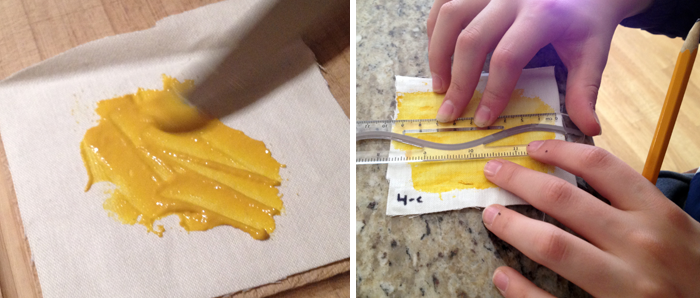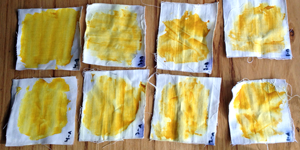Quick and Dirty Science--Testing Laundry Detergents
A student investigates whether enzymes are the key to laundry stain removal.

"I need a science project that has a real-world application," said my 7th grade son. "Our teacher says we can't just put Mentos in a bottle of soda." "Fair enough," I thought. While a soda geyser has a big "wow" factor, by middle school, experienced science fair participants are often ready for more sophisticated experiments.
My son enjoys hands-on projects, but he didn't have a specific topic in mind, so he used the Science Buddies Topic Selection Wizard to get some suggestions. The Are Enzymes in Laundry Detergents Effective Stain Removers? project immediately grabbed his attention because he knew it would pass muster with his teacher. After all, what is more real-world than laundry? Clothes stained with food, grass, dirt, and other substances are part of life. Scrubbing can help remove those stains physically, and enzymes in laundry detergents can help remove them chemically. Enzymes are proteins that help chemical reactions occur, and some laundry detergents use them to increase the chances that the detergent can break down stains in clothing.
Easy Supply List, Fast Set Up
After learning more about enzymes and which types of laundry detergents contain them, my son made up a shopping list, and we headed to the grocery store. He decided to test three different types of detergent—two with enzymes and one without. Everything else—a big jar, some light-colored cloth, mustard, and a permanent marker—was already in the house.
The set up for this project was straightforward. He carefully measured out equal amounts of mustard and spread it onto squares of cloth he had cut from an old shirt. He wrote a number on the corner of each square with permanent marker so he could easily keep track of which square was washed with which detergent.

Let the Shaking Begin!
After leaving the mustard to dry overnight, it was time to test the detergents. First, he carefully measured the sizes of the mustard stains with a ruler so he would have a way to tell how much of the stains disappeared after washing. Next, he measured water and detergent into a large jar, added a piece of the stained cloth, set the timer for three minutes, and started shaking the jar. Part way through the three minutes, he realized that he was going to have to repeat the shaking process eight more times. That was a lot of shaking!
As each square of cloth came out of his mini, hand-powered "wash cycle," he was disappointed. It seemed that the stains hadn't shrunk in size at all. "Was mustard something that enzymes couldn't break down?" he wondered.
However, as the cloth squares dried throughout the day, he could see that parts of the stains were much lighter on some pieces of cloth. So, the project wasn't a bust after all—he just needed to adjust how he was measuring the changes in the stains. When all of the squares were dry, it was clear that one detergent had done a better job of removing the mustard.
Thinking Like a Scientist
Was this project as exciting as a soda geyser? Maybe not, but it still got a thumbs-up from my son "because the way enzymes work is pretty cool." He had definite ideas about what he would do differently if he were to repeat the experiment: less mustard on each square so the detergents would have a better chance of working, and he would also run the squares through the washing machine so they had a more realistic wash cycle.
Overall, the project was a positive experience for my son, because the setbacks he encountered encouraged him to problem solve like a scientist. How could he analyze the results of his experiment, even though they weren't what he anticipated? How could he improve the process? He learned that even when you don't get the results you expect, a project can still be a success!
Categories:
You Might Also Enjoy These Related Posts:
- Plastics and Earth Day - Science Projects
- Arduino Science Projects and Physical Computing
- 10+ Robotics Projects with the BlueBot Kit
- 5 STEM Activities with Marshmallow Peeps
- March Madness Basketball Science Projects: Sports Science Experiments
- Women in STEM! More than 60 Scientists and Engineers for Women's History Month
- Explore Artificial Intelligence and Machine Learning with Student AI Projects
- 10 Reasons to Do the Rubber Band Car Engineering Challenge










